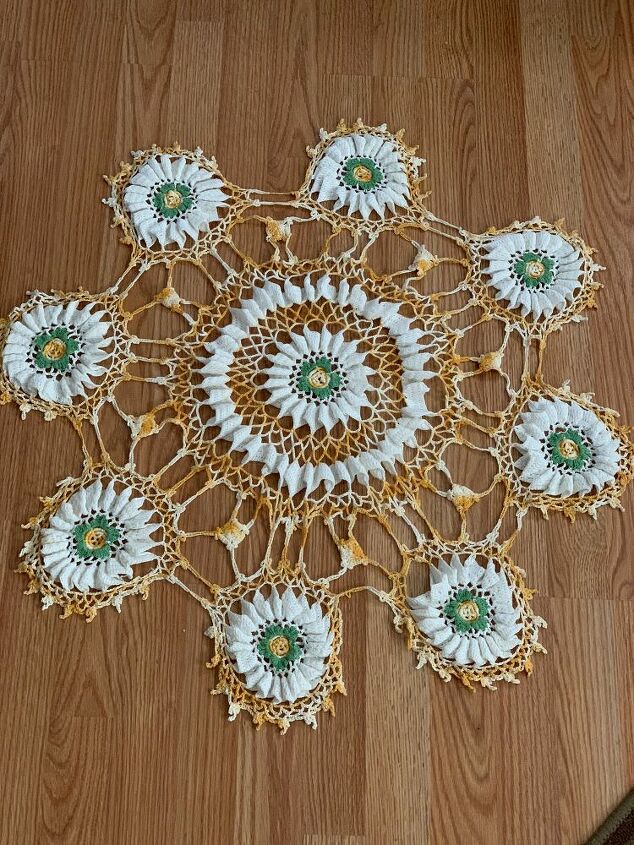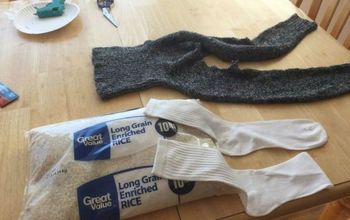Needing to know if this is handmade if any of you talented people know and the value I found it the other day at a sale and I like the colors I thought it looks to be handmade and if so took lots of work.....Thanks for any info you may have on it......Thanks
Does anyone know the pattern name of this and if it's handmade?
Related Discussions
Review: Command Hooks Are Life Savers! What Do You Use Them For?
I LOVE these little life savers. I'm a renter so I always have to find that balance between making my space mine and making my landlady angry.That's why I'm crazy abo... See more
Southern Traditions: Why Did My Grandmas Sweep Their Yards?
My question as I watched these grandparents was always, "Why are you sweeping your yards, and why is there no grass around your house?" We have grass around ours.
What Are Some Unexpected Uses for Dryer Sheets?
I looove using dryer to sheets to make my cloths smell great, and I know that they have a bunch of other surprising, helpful uses as well. What are some unexpected wa... See more
Help me overcome my fear of drills!
I'm getting a drill for as a birthday present I'm really excited, but I'm also concerned. I have a bit of a fear of power tools.What are your best safety tips for han... See more
Can you help us coordinate our TV stand with existing End Tables?
A TV stand is not available in the style of our end tables. It has been recommended to us that we look for a TV stand that is in contrast to the two tables (photos p... See more
Cleaning TIPS Challenge!!!
We challenge you to share your favorite Cleaning Tips with the Hometalk Community for the chance to win a a fun prize!!(Start a discussion with your entry- http://www... See more








Yes, handmade. Crocheted.
Definitley looks hand made. Do you know anyone that has been crocheting for a while?
I believe she is looking for the stitch style name. Only someone whose family has a history in this stitch pattern may know the name.
Yes it's handmade. May not be a specific pattern but a combination.
yes most definitely handmade Crochet & it is mixture of patterns ; few ripped areas need hand sewn back together; unfortunately they don't have much value which is a shame it's become a lost art;you can look on Ebay or Etsy to get price ranges;It's most likely cotton-gently hand wash cold water with Woolite or even baby shampoo rinse well then lay flat to dry straightening out each & every edge,these were many times starched to keep shape; here's how to stiffen/starch them------Many of the doilies today are machine-made instead of handcrafted, but you scarcely notice. When you stiffen a doily and use it for a lacy decorative table setting, the effect is guaranteed to be stunning. You have many options for stiffeners, from watered-down white glue to chemical-laden sprays purchased at the store. Try your grandma's and great-grandma's recipe instead. Sometimes the old-fashioned things are best, just like your doilies.1Fill a small saucepan with 1/2 cup of water. Add 1 1/2 cups of sugar and stir thoroughly. A whisk works best but a spoon will suffice as long as you pay attention to the pan's bottom edges. 2
Place the pan on a stove burner set to low heat. Continue stirring as the sugar water heats. A low simmer is fine, but don't let the mixture boil. Watch for the sugar water to turn a clear color with a fluid texture, not sugary and white.3
Turn off the burner -- removing the pan if the stove is electric -- and allow the sugar starch to cool to about room temperature.4
Dip each doily into a sink filled with very warm water. Lay the doilies on an absorbent bath towel and roll up the towel to blot up the excess water. Wetting the doilies prevents the fibers from absorbing excessive starch. The fibers are fragile when wet, however, and wringing, twisting and pulling on a doily will stretch it out of shape, especially when it's wet.5
Drop each doily, one at a time, into the sugar starch. Wait a minute or two, then retrieve the doily and, holding it over the pan or your sink, gently squeeze the doily or press it between both of your hands to remove as much excess sugar starch as possible. Avoid wringing, twisting, stretching actions.6
Lay each doily on a fresh, absorbent bath towel, leaving a little space around each one. Shape the doilies as appropriate -- squaring or rounding into a circle for instance and smoothing out ruffles.7
Tack the doilies with stainless steel sewing needles or pins to prevent shrinkage as they dry. Leave them in an undisturbed area where they will not be exposed to dirt -- wet, sticky surfaces such as created by sugar starch attract dirt -- for a day or so. Remove the pins and use as desired once they are dry.Things You Will Need
- Sauce pan
- Sugar
- Measuring cup
- Whisk or spoon
- Absorbent bath towels
- Sewing pins or needles
TipsLooks beautiful! I'd love to know how to make this too
Yes, this is handmade and it's crochet done with fine thread and very small metal hooks. I learned to crochet from my mother when I was about 5 and have been doing it for more than 70 years now. Crochet has changed, a lot, since the days of this doily. Bulkier yarns and larger hooks make the work go faster and much easier...easier on the eyes! I have taught my three granddaughters to crochet with the larger hooks and fuller yarns. It is a skill that is on a comeback now, with a lot of people showing interest in it again, thank goodness. The above answer gives instructions for a true way to treat and prepare this doily and it will preserve it also. I have several of my own and many that my mother and grandmother made and I consider them treasures. They take many hours of work and are hard on the eyes. I don't do this type of crochet anymore. I'd rather work with the heavier yarns. Anyone wanting to learn is fortunate because there are many instructional videos on YouTube and thousands of free patterns on the internet. New stitches are being created all the time. It is not difficult to do, but does take practice. I'm still learning some of these new stitches and I still love seeing my finished projects.